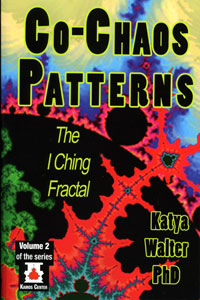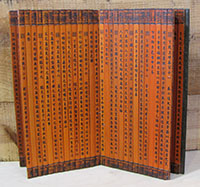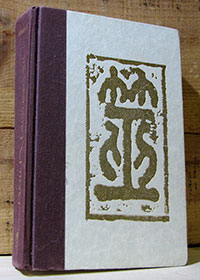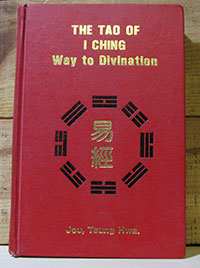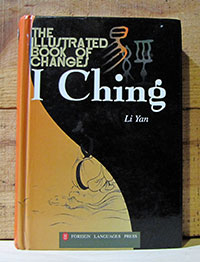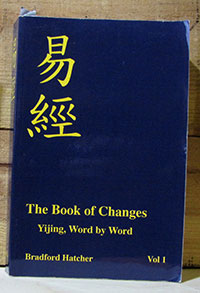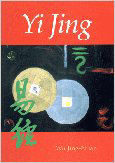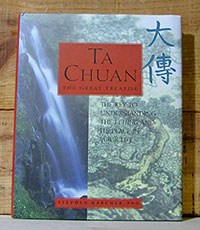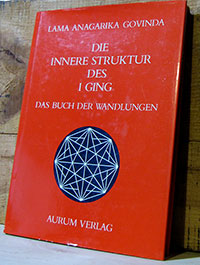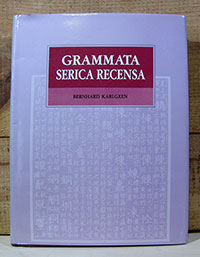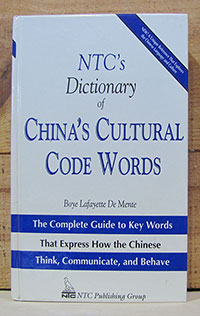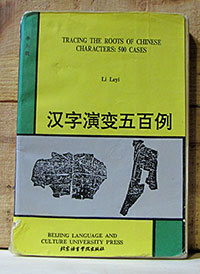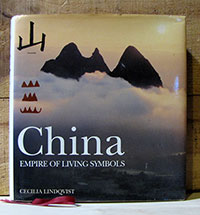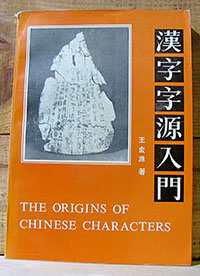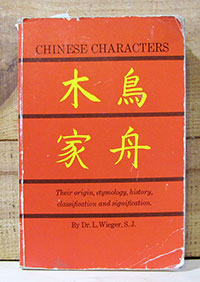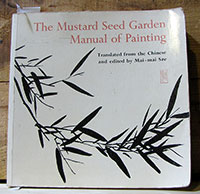I Ching, Yijing or Zhou Yi
"Oracle of the moon": © 2000 LiSe
 Yi Jing, Oracle of the Moon
Yi Jing, Oracle of the Moon

Books
which have been - and most still are - of value to me. I have often no information about sellers, some are out of print, but it should be possible to find most on the internet.
Still missing: Wilhelm, Legge, Ritsema-Karcher and many others. They will be added too.
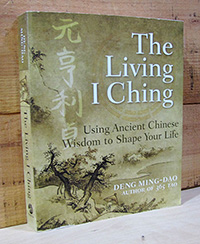 |
Deng Ming-Dao, "The Living I Ching, using ancient Chinese wisdom to shape your life". |
|
 |
Harmen Mesker "Yijing astrologie". Buitengewoon degelijk en uitgebreid. Hij heeft de fouten en vergissingen in bestaande yijing-astrologie boeken herberekend, waardoor dit een betrouwbaar standaardwerk is geworden. | |
| Katya Walter wrote a series of 6 (or 7?) books, called Double Bubble Universe. The universe has a master code which made it possible to come into existence - The Yi is the shorthand for that code! You will find the I Ching mentioned in all those books, often very extensively. A MUST-READ! |
||
| Yi Jing printed on bamboo slabs. No idea how old it is. Not ancient: it was probably printed with a printer, and the 'silk' of the back is not silk. But all the same very beautiful. | ||
| Alfred Huang "The complete I Ching". Beautiful book with much information. Traditional and yet also interesting and good to consult. ISBN 0-89281-656-2 | ||
| Joe Tsung Hwa "The Tao of I Ching, Way to divination". A beautiful fortune-tellers I Ching with old illustrations. Ed.:Tai Chi Foundation, distr.: Charles E. Tuttle Co. You will love it! |
||
|
Li Yan, The illustrated book of changes I Ching". Beautiful! |
||
| Bradford Hatcher, "The Book of Changes Word by Word". Translation with concordance and a huge lot more. Very good! | ||
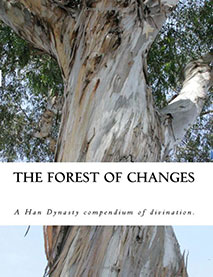 |
The Yi Lin, Forest of Changes, has been written around 25 BCE by Jiao Shi (Jiao Yanshou) or Xu Jun. It has a verse, usually of four x four characters, for every possible change from one hexagram into another.
It seems the 'change' is from the hexagram of the particular day, to the hexagram you cast yourself. |
|
| A very 'Chinese' one: Hua-Ching Ni, THE BOOK OF CHANGES AND THE UNCHANGING TRUTH. Traditional, with a lot of information about constellations, stems and branches, cycles, and with hexagram guidance for marriage, looking for something lost, climate and so on. ISBN 0-937064-29-7 Some charts from his book: HERE | ||
| Wu Jing Nuan "Yi Jing". Beautiful Yijing. With handwritten Chinese text and translation. ISBN 0-8248-1362-6. Wu has a website at wusherbs.com about herbs. His Yi Jing gives very nice background information. I love this one. |
||
| Stephen Karcher, Ta Chuan. A beautiful translation. Speaks to your soul. | ||
| Lama Anarika Govinda, "Die innere Struktur des I Ging". With many tables and structures, very good. | ||
| Bernhard Karlgren, "Grammata Serica Recensa". Teacher of Cecilia Lindqvist. A must-have! I found every character I searched for, so there cannot be many not mentioned. ISBN 957-638-269-6. I could only find it at www.bookfinder.com Kunst (below) has a concordance which gives for every character the number it has in GSR. If you cannot read any Chinese, it is still possible, with Kunst + GSR, to find the old meanings yourself! In this website referred to as 'GSR.123', the number is the entry. |
||
| Boye Lafayette de Mente, China's cultural code words. Many of those are hexagram names of the Yijing. | ||
|
Li Leyi, "Tracing the roots of Chinese characters". This one introduced me to etymology. It was my first encounter with those ancient picture-words. 'Only' 500 characters, but each one illustrated. Very nice book! I have a spare copy, mail for price
|
||
| Cecilia Lindqvist "China empire of living symbols". Wonderful book!! Still available online (Amazon etc), also in Dutch translation. |
||
| Wang-HongJuan "The origins of Chinese characters". Excellent, much more up to date than Wieger. Not all characters, but many very interesting ones. ISBN 7-80052-243-1 |
||
| Wieger "Chinese Characters". The first one about etymology, very good, but from 1924, so since then many new discoveries have been made. ISBN 486-21321-8. In this website referred to as "L-W".
ANALYSIS OF CHINESE CHARACTERS by Wilder and Ingram. Good, after Wieger, as far as I could see: more characters, but also more difficult to find. Like Wieger: a lot is outdated. |
||
| The Mustard Seed Garden Manual of Painting, from the 17th century. Beautiful. | ||
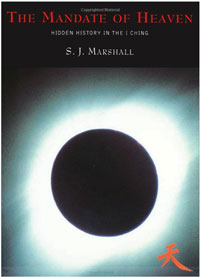 |
'THE MANDATE OF HEAVEN, hidden history in the I Ching', by S.J.Marshall. About old meaning of 'Yi', the Gu of hex.18, the solar eclipse of hex.55, the corpse of the army, the MingYi bird (about pheasants and meteorites, the crow eating the sun, and about Yi shooting it), the melon, the skin on the thighs, the dragon and rain. And many other clarifications, all very well documented. I love it. | |
| Already 'vintage' but one of the first who began to look for original meanings in the Yi: Gregory Whincup REDISCOVERING THE I CHING. Very good. Gives reasons for the way he translates. ISBN-10: 0312141319, ISBN-13: 978-0312141318 | ||
| A DICTIONARY OF EARLY ZHOU CHINESE by Axel Schuessler. Many examples from old texts, how the old characters were used: Huge, very accurate and extensive. |
||
| Richard Kunst, THE ORIGINAL YIJING. DISSERTATION 1985. Very good, with concordance. A must for everyone who wants to know about the Yi, or who wants to translate himself. Obtainable at same address as next one (Shaughnessy's). University of California, Berkeley, 1985 - 1328 pages |
||
| Edward Shaughnessy, THE COMPOSITION OF THE 'ZHOU-YI'. Ph.D. dissertation Stanford University 1983. University Microfilms International. 300 N. Zeeb Road, Ann Arbor, MI 48106, USA (not all hexagrams) See also "Bagua numerals" |
||
| Richard Rutt, ZHOUYI, the book of changes. Loaded with information, good translation, Wings also included, searched for the old meanings (like Kunst), and tried to make a text like the original Yi might have been: with rhymed folk-wisdom. A page about the bagua. Published in England (Curzon). ISBN 0-70007-0467-1 | ||
| Far-East Chinese English Dictionary. In this website referred to as 'F-E.123', the number is the entry. | ||
| Mathew's Chinese English Dictionary. In this website referred to as '[M.123]', the number is the entry. | ||
| The Penguin DICTIONARY OF SYMBOLS. Jean Chevalier and Alain Cheerbrant, transl. John Buchanan. 1996 ISBN 0-14-051254-3 | ||
| CHINESE SYMBOLISM AND ART MOTIFS by C.A.S.Williams. ISBN 0-8048-1568-0 Tuttle comp. Japan | ||
| A DICTIONARY OF CHINESE SYMBOLS Wolfram Eberhard. Diederichs Verlag (German, 1983), Routledge 1995, ISBN 0-415-00228-1 | ||
| Edward Shaughnessy, BEFORE CONFUCIUS. 1997, State Univ. of New York. ISBN 0-7914-3378-1 Lots of information on old texts, not easy. | ||
| Richard Bertschinger THE SECRET OF EVERLASTING LIFE, translation of CanDong Qi, a text of the 2nd century on transformation and immortality. Good! Taoist meditation methods. Element Books, ISBN 1-85230-568-1 | ||
| Carol Anthony wrote several books about the I Ching. All based on Wilhelm, but with very valuable ideas, although restricted to her own views. Books by Anthony: Guide to the I Ching; Love, an Inner Connection. The Other Way. A Book of Meditation. The Philosophy of the I Ching. I CHING: updated and edited by Carol K. Anthony and Hanna Moog. |
||
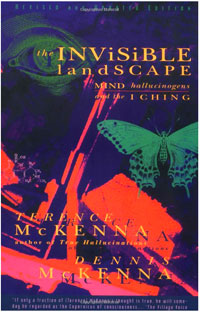 |
THE INVISIBLE LANDSCAPE, Mind, Hallucinogens and the I CHING, by Terrence & Dennis McKenna, (published in 1975, update in 1993) in which they present a very interesting version of "what King Wen may have done" to formulate his Sequence. | |
| ' Magick, shamanism and Taoism', The I Ching in Ritual and Meditation by Richard Herne, Llewellyn Publications, St. Paul MN, 2001, 346 p., ISBN 1-56718-207-0. An excellent review by Michelle Moruud HERE | ||
|
